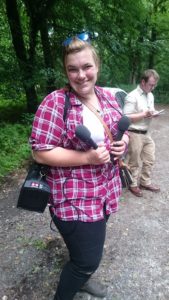Theresa Reichlin from the University of Toronto and winner of the 2017 Prince of Wales Forest Leadership Award tells us about her work placement with 2017 Award Programme employer Pryor and Rickett Silviculture. She is a member of the Canadian Institute of Forestry/Institut forestier du Canada (CIF/IFC).
The five months between finding out about my award and the start of my internship went by really quickly and still being in study and field course mode, I barely had any time to prepare. My visa and driver’s license situation were sorted out already due to the special nature of my heritage. So essentially, as with many other things in my life, I hopped right in without any expectations.
Visit to Duchy Estate

I visited my work placement employer, Pryor and Rickett, on the Friday before my official start date. On Tuesday, I met Andy Lederer, Development Director at the Institute of Chartered Foresters (ICF), Geraint Richards, Head Forester at the Duchy of Cornwall, and Dana Collins, Executive Director at the Canadian Institute of Forestry/Institut forestier du Canada. Due to commuting arrangements I got the opportunity to shadow Andy, from ICF, for a day before starting my work placement. On my first day I got to see ICF’s Bristol office and the Forestry Commission of England’s office.
Spending the evening with Dana, Geraint, Andy, Reggie and James was an exceptional experience. Being surrounded by such fantastic individuals and knowing that one day there may be a connection in order to achieve something great on a global scale is the best feeling in the world. My stomach was full of very busy butterflies all night and the day after. We all met with the Royal Forestry Society at the Duchy of Cornwall’s office and took a tour of some of the woodlands in Newton Park Estate. I’ve been exposed to challenges that Britain’s forestry faces, such as the Himalayan balsam, the grey squirrel, and ash dieback.
Starting with Pryor and Rickett
After visiting the Duchy of Cornwall’s estate, I went to Pryor and Rickett. My first week was basically like throwing a sponge into a tub of water – there was so much new information, both forestry and non-forestry related, but only so much I could retain. My work colleagues and supervisors very kindly welcomed me to their social circle, they are always available for my endless questions (although apparently someone had a sore throat from answering too many of them) and they’ve been inviting me along to their social outings. I’ve already been to several pub quizzes and a cider festival. Hereford is the cider capital of England, so there is so much to see and taste. I was surprised to find that not all ciders in the UK have bubbles – which is kind of nice, but something we don’t see in Canada.

My first 2 weeks at Pryor and Rickett mostly consisted of learning new skills, buying a pair of pink (!) wellies, introductions to the British Ordnance Survey maps, new mapping software MapInfo (which I still struggle with), gaining confidence to drive stick-shift on the left side of the road and constantly telling locals that in fact I’m not American! I’ve also had the pleasure of learning about brambles (blackberry bushes) which are not too pleasant to walk through. Their little thorns get stuck in everything from hair to shirts to trousers and skin too. I helped my situation by wearing a pair of sturdy work pants (trousers) which make walking through them a little easier.
Woodland Heritage

Soon after I started, I was invited to the Woodland Heritage field weekend – it was a very educational couple of days, which introduced me to more topics such as Acute Oak Decline, the importance of good silvicultural techniques in furniture production, and the use of very high-tech methodology in producing very fine garden furniture. I also got to see some very impressive estates which have been run by the same family for over 200 years. The Woodland Heritage crowd is so knowledgeable and it was a pleasure to be surrounded by legendary figures of British Forestry. I helped out with the PA system for the speakers and was awarded a book about British Oak trees, signed by the author – Archie Mills.
Squirrels and cricket bats
The coolest thing during the first few weeks was my very first task which was to inspect plantations of cricket bat willows. Cricket is a nationally important sport in the UK and success starts at the roots – of the bat willows that is. That is where I saw the serious impacts the Eastern Grey Squirrel is having on the British Timber industry. Apart from ringbarking bat willows, it also damages oak, beech, sycamore, chestnut and a few others.
Thank you Theresa, looking forward to your next blog.
Follow The Prince of Wales Forest Leadership Award #ForestLeaders






